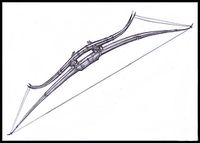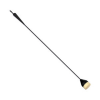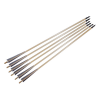Greatbow (Weapon)
Jump to navigation
Jump to search
| Greatbow | 2-Hand Projectile / Exotic | [edit] | |||||||
|---|---|---|---|---|---|---|---|---|---|
| Cost | Sm Dmg | Med Dmg | Large Dmg | Crit | Range | Wt | Type | ||
| 150 gp | 1d8 | 1d10 | 2d8 | x3 | 120 ft | 6 lbs | Piercing or by ammunition | ||
| Weapon Qualities: Non-Melee | |||||||||
| The greatbow is a rare but extremely powerful weapon. Also called a double bow or war bow, the greatbow is physically not much larger than a longbow. However, because of the exotic double-limbed design, the greatbow has a much heavier draw weight and a considerably longer draw than a longbow of equal size, while the limb speed is considerably higher, since thinner, more responsive limbs can be used. Since a greatbow must be drawn back further than a longbow (usually to the point of the jaw or even further), it requires an exotic weapon proficiency to use properly. The greatbow belongs to the "Bows" weapon group. | |||||||||
Show / Hide Ammunition Types
| Ammo Type | Cost | Sm Dmg | Med Dmg | Large Dmg | Crit | Range | Wt | Type | ||
| Common Arrow | 5 cp each | 1d8 | 1d10 | 1d8 | x3 | 120 ft | 0.1 lbs each | Piercing (physical, common) | ||
| Weapon Qualities: Expendable | ||||||||||
| Common arrows are standard bow ammunition. They have sturdy diamond points on them, they're shafted with easy to get ash, maple, or willow, and they have reliable goose-feather fletchings. They do a bit less damage in shortbows than they do in longbows, and a bit less damage in longbows than they do in greatbows. A common arrow is denoted by that classic, deadly but easy to make, diamond-shaped point. It's good against armor, it's good against beasts, and it can be made quickly. You'll see these everywhere, and rightly so, because they're great. | ||||||||||
| Ammo Type | Cost | Sm Dmg | Med Dmg | Large Dmg | Crit | Range | Wt | Type | ||
| Barbed Arrow | 2 gp each | 1d6 | 1d8 | 2d6 | x3 | 60 ft | 0.5 lbs each | Slashing (physical, common) | ||
| Weapon Qualities: Expendable, Weapon Qualities: Special | ||||||||||
| The barbed arrow is a specialty product, since making that extravagant head takes a lot of time and skill. Barbed arrows are based off broadhead arrows, with all their characteristics, but they do the same damage as flight arrows. So why bother with them? Because to remove a barbed arrowhead is a deadly and dangerous process. To remove a barbed arrow after you've been struck by one and taken damage past any DR requires greater than animal intelligence and a heal check against an Easy DC. Either the victim or an adjacent creature can attempt to remove barb heads. Failing the heal check means removing the barbed arrow inflicts 1d6 of additional damage which cannot be reduced by DR. Ouch. | ||||||||||
| Ammo Type | Cost | Sm Dmg | Med Dmg | Large Dmg | Crit | Range | Wt | Type | ||
| Blunt Arrow | 5 sp each | 1d8 | 1d10 | 2d8 | x3 | 60 ft | 0.5 lbs each | Bludgeoning (physical, common) | ||
| Weapon Qualities: Expendable | ||||||||||
| Take a broadhead arrow and remove that big, deadly steel point. Replace it with a shaped boiled-leather cup into which a tightly rolled mass of cotton cloth is firmly wedged, presenting the firm, flat side of the roll toward the front of the arrow. What you get is the blunt arrow, which does bludgeoning damage rather than piercing damage. Why would you do this? Well, hunting of some delicate game species is easier with blunt arrows. Blunt arrows have the same construction as broadhead arrows, but to keep that heavy, flat tip pointed right, they suffer a reduced range increment. | ||||||||||
| Ammo Type | Cost | Sm Dmg | Med Dmg | Large Dmg | Crit | Range | Wt | Type | ||
| Broadhead Arrow | 3 sp each | 1d10 | 1d12 | 3d6 | x3 | 60 ft | 0.25 lbs each | Piercing (physical, common) | ||
| Weapon Qualities: Expendable | ||||||||||
| The obvious difference to a broadhead arrow is the head, which is a heavy delta-shaped thing with sharp wings and modest barbs. They have more steel in them than common heads, and the blacksmith has to spend some time on them compared to diamond points. The shaft of the broadhead arrow is made of a dense, heavy wood like buckeye, hickory, or dogwood to maintain the proper spine with that heavy head on it. And instead of three fletchings a broadhead arrow has four, to keep that big-winged head pointed the right direction. As a result, broadheads are expensive, short-ranged, and weigh over twice as much as a standard arrow, but they hit really hard. | ||||||||||
| Ammo Type | Cost | Sm Dmg | Med Dmg | Large Dmg | Crit | Range | Wt | Type | ||
| Flaming Arrow | 3 gp each | 1d6 | 1d8 | 2d6 | x3 | 60 ft | 0.5 lbs each | Piercing (physical, common) | ||
| Weapon Qualities: Expendable, Special | ||||||||||
| Flaming arrows are an age-old terror weapon. Flaming arrows are based off broadheads, as the dense, hardwood shafts are required to allow them to do their fiery work. The massive broadhead is removed and replaced with a small needle-like head with a hole in it. Through the hole is threaded a soft rag of cotton, wool, or linen and the whole thing is soaked in tar and wrapped around the head and top of the shaft. This is allowed to cool into a solid, flammable mass. Lighting a flaming arrow requires a move action and access to a considerable source of flame (larger than a torch, such as a good fire or a brazier). Any amount of magical flame will touch one off, as well. Once lit, a flaming arrow burns for 5 rounds, regardless of wind or rain, although being underwater or doused by a bucket will extinguish it. Flaming arrows do piercing damage as above, as well as 1d4 of fire damage to creatures struck. When fired at flammable structures like cloth wagon covers, thatch roofs, haystacks, etc, they ignite such things automatically the next round unless doused. On light wooden structures they ignite on a 1-2 on a d6 roll. On heavy wooden structures they ignite after three rounds on a roll of 1 on a d10. See the Environmental Effects rules for how to put things out again. Fire Arrows get really scary when you fire a few hundred of them at once.... | ||||||||||
| Ammo Type | Cost | Sm Dmg | Med Dmg | Large Dmg | Crit | Range | Wt | Type | ||
| Flight Arrow | 5 sp each | 1d6 | 1d8 | 2d6 | x3 | 160 ft | 0.05 lbs each | Piercing (physical, common) | ||
| Weapon Qualities: Expendable | ||||||||||
| Flight arrows are designed for the maximum possible range. As a result, they use common diamond-tip arrowheads in good quality steel but in very small sizes. The shafts are made of kiln-dried lightweight woods, like alder, fir, spruce, or cedar. And the fletching is small, often made of chicken feathers rather than goose. The result is an arrow that is the same size as a regular arrow but weighs about half as much and is ridiculously streamlined. Flight arrows shoot like lightning, and are what are used in target shooting competitions. | ||||||||||
| Ammo Type | Cost | Sm Dmg | Med Dmg | Large Dmg | Crit | Range | Wt | Type | ||
| Whistling Arrow | 1 gp each | 1d6 | 1d8 | 2d6 | x3 | 120 ft | 0.1 lbs each | Piercing (physical, common) | ||
| Weapon Qualities: Expendable, Audible | ||||||||||
| Take a common arrow, replace that simple but elegant diamond point with a whistling cage made of bent rod, and you create a whistling arrow. These are audible in flight to a distance of 50 feet from the path of their flight, so they're pretty darn loud. They make a distinctive falling shriek as they fly that sounds eerie, especially if you get a few hundred going all at once. Great fun, but expensive. Whistling arrows even do reasonable damage, since they have a functional chisel point atop the whistling cage. | ||||||||||





